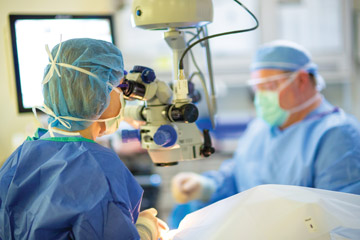Surgeons spend years learning surgical techniques — how to handle instruments, how to make a stitch, how to expose tissue — with very little instruction or emphasis placed on proper ergonomics and posture, according to Michael Lidsky,
MD, a gastrointestinal surgeon at Duke Cancer Center in Durham, N.C. "We're taught how to be a surgeon, but not how to be a healthy surgeon," he says. "Physical discomfort has long been viewed as part of the job."
During his residency, Dr. Lidsky sat in on an ergonomic workshop that completely changed his outlook about the physical demands of surgery. "I had been experiencing lower neck pain, and checked all the boxes for an ergonomic injury," he explains.
The ergonomics expert who ran the workshop later observed Dr. Lidsky performing surgery and offered useful tips for improving his posture. Your surgeons might not have access to an ergonomics expert, but their colleagues can offer a knowing
perspective on how to maintain proper posture beside the OR table.
"Surgeons can ask one of their partners to watch how they perform surgery to assess and tell them if there are things they could change," says Dr. Lidsky. "Another perspective can provide insights on techniques and postures that surgeons can't
possibly have on their own."
You can also take pictures of how surgeons stand at the table or position their instruments. After surgery, surgeons can review the images to see how their form compares to how they think they're operating. John Jarstad, MD, an ophthalmologist
affiliated with the University of Missouri in Columbus, had photos taken of himself performing cataract surgery. What he saw made him cringe: His neck was extended too far forward, and he was leaning off to the side instead of centering
himself at the microscope's oculars.
Dr. Jarstad, and countless ophthalmologists like him, sit hunched behind microscopes for hours on end during busy days of surgery, unable to move their arms and shoulders more than a couple inches as they perform some of surgery's most intricate
maneuvers. Even the relatively brief cataract procedures can cause lasting injuries to necks, backs and shoulders.
In 2006, Dr. Jarstad found out just how physically damaging his chosen career was when he ended up on the other end of the knife. "A bulging disk in my back caused numbness and weakness in my legs," he says. "I put up with it for a long time
and tried everything — physical therapy, seeing a chiropractor — but nothing provided relief. I finally had to resort to undergoing a microdiscectomy."
Dr. Jarstad says he's amazed by how many ophthalmologists he's spoken to who've also had back surgery. Eye surgeons being forced into retirement because of repetitive strain injuries is "not an uncommon story," says Dr. Jarstad.
Surgery cured Dr. Jarstad's aching back, but it was the steps he took, some seemingly simple, to improve his posture that helped make surgery more tolerable.
"I'm now much more cognizant of my posture, making sure I'm sitting [square to] the patient," says Dr. Jarstad. He also raises the OR table, allowing him to sit up higher and extend his legs, a posture that puts less strain on his back. Plus,
some surgical microscope manufacturers offer ocular extensions, allowing surgeons to operate in a more upright posture with their spines in a neutral position.
Placing video monitors in ergonomically advantageous positions around the OR table also impacts surgeon posture. Monitors mounted on floor-based towers are often placed at the foot of the bed, according to Dr. Sutton. "And that would mean
I'm constantly looking over my left shoulder, putting strain on my neck and shoulders." ?
Boom-mounted monitors provide the versatility surgeons need to operate in comfort. Dr. Sutton positions the center of a monitor on the opposite side of the surgical site in a direct line with her nose, so she can track the movement of her
instruments on the screen without turning her head.
She also steps on lifts to make sure her elbows are properly positioned, especially while operating on obese patients, who make up a higher percentage of the patient population than when she was in training. "Laparoscopic surgeons need to
be able to comfortably manipulate instruments with their elbows at their sides and hands extended directly in front of them," she says.
Dr. Lidsky agrees. "Surgeons need to get the table low enough — or themselves high enough — to relax the shoulders," he says, "which offloads the wrists."
.svg?sfvrsn=be606e78_3)

.svg?sfvrsn=56b2f850_5)